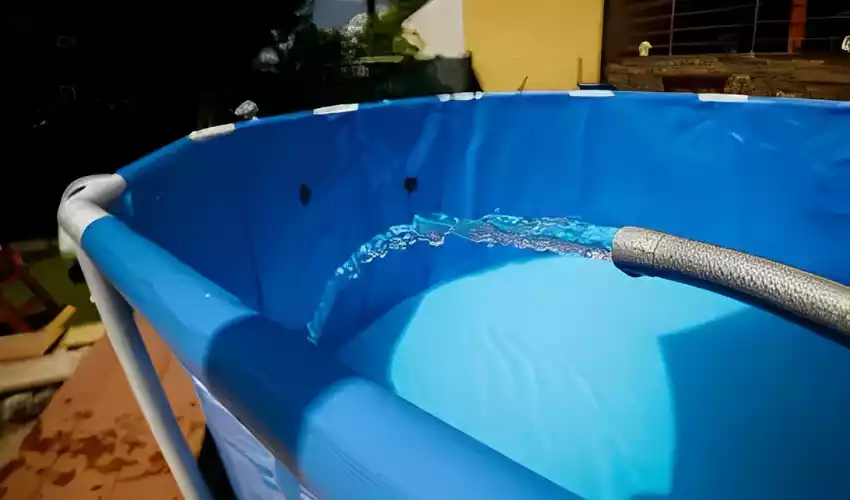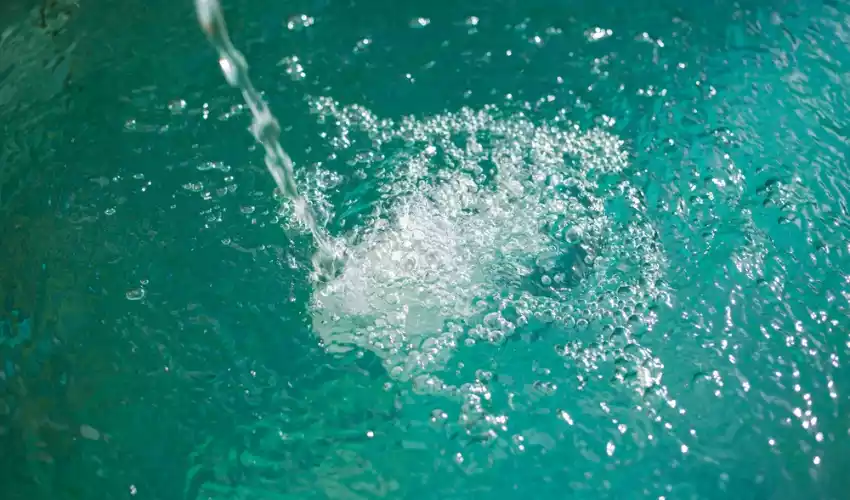Swimming pools are often the heart of summer fun and relaxation. But when it comes to filling them up, the source of water can play a crucial role in ensuring quality and sustainability. Well water, a common choice for many, emerges as a promising alternative to municipal sources.
Filling a swimming pool with well water involves drawing water from natural underground reservoirs. While this method can be economical and environmentally friendly, it necessitates particular care in terms of treatment and maintenance to ensure the water’s safety and clarity.
Well water, inherently rich in minerals, demands a tailored approach. The unique characteristics of this natural water source, combined with its economic and environmental implications, make it a significant consideration for pool owners.
Pros and Cons of Well Water
Utilizing well water for filling swimming pools has been a growing trend due to its perceived benefits. However, just like any other solution, it presents its own set of advantages and challenges. In this section, we’ll delve deeper into the pros and cons of using well water for swimming pools.
Natural Filtration Process
Well water generally benefits from the Earth’s natural filtration system. As water permeates through layers of soil and rock, many impurities get filtered out. This means:
- Reduced Chemicals: Unlike municipal water that often contains chlorine and fluoride, well water is often free from these additives.
- No Industrial Contaminants: Areas that aren’t industrialized tend to have well water that’s free from industrial pollution.
- Fresh Source: Due to its underground origin, well water can be cooler and may feel fresher, especially in the summer months.
However, it’s essential to note that natural doesn’t always mean pure. Some underground sources may still contain contaminants.

Mineral Content Concerns
While well water is naturally filtered, it often picks up minerals as it moves through rock formations. This mineral-rich content can have implications:
- Iron Presence: High iron levels can lead to brownish discolorations in pools. Over time, this can stain the pool lining and require regular treatment to keep the water clear.
- Calcium Build-up: High calcium content can lead to scaling, where calcium deposits form on the pool tiles and filters, affecting the pool’s appearance and equipment efficiency.
- Magnesium and Others: Other minerals can also affect water balance and clarity.
Impact on Pool Maintenance
The unique composition of well water means pool maintenance can differ compared to using municipal sources:
- Frequent Balancing: Due to its mineral content, well water might require more frequent testing and balancing to maintain optimal pH and hardness levels.
- Equipment Wear and Tear: High mineral levels can expedite the wear of pool equipment, demanding early replacements or repairs.
- Specialized Treatments: Pools filled with well water may need specific treatments to combat the issues arising from its mineral content.
Pre-Filling Checks
Ensuring a pool is filled smoothly with well water requires some pre-filling preparations. Let’s explore these in depth:
Assessing Well Capacity
It’s vital to ensure that your well can supply the volume of water needed without running dry:
- Volume Calculation: Determine the volume of your pool and compare it to your well’s yield. This helps ensure your well can support the fill without depletion.
- Resting Periods: For wells with a slower recharge rate, consider filling the pool in stages, allowing the well to replenish.
Water Table Implications
Understanding the water table is crucial when using a significant volume from a well:
- Seasonal Changes: Water tables can fluctuate with seasons. A period of heavy rain might raise the water table, whereas a dry spell can lower it.
- Sustainable Drawing: Overdrawing can lead to a decreased water table, affecting not only your pool but also the well’s longevity and the surrounding environment.

Testing for Contaminants
While well water is naturally filtered, it isn’t immune to all contaminants:
- Routine Tests: Regularly test your well water, especially before a large draw, to ensure no harmful bacteria or chemicals are present.
- pH and Hardness: These tests help determine the water’s balance, ensuring you won’t face scaling or corrosive issues once it’s in the pool.
By investing time in these pre-filling checks, you’re setting the stage for a smoother, more efficient pool-filling process with well water.
Filling Process Steps
Using well water for your pool requires attention to detail during the filling process. Here’s a more detailed guide:
Sourcing a Good-Quality Hose
The right hose ensures efficient filling without introducing contaminants:
- Material Consideration: Opt for hoses that are lead-free and resistant to UV rays to prevent degradation and contamination.
- Diameter and Length: Larger diameter hoses fill faster. Ensure the hose length comfortably reaches the pool without excessive coiling, which can hinder water flow.
Managing Pool Fill Rate
The rate at which you fill your pool can impact both the well and the pool:
- Avoid Overdrawing: Filling too fast can strain the well, especially if it has a low yield. This can lead to sediment being drawn, clouding the pool water.
- Monitor Changes: As the pool fills, regularly check the water’s appearance and taste. Any sudden changes can indicate issues with the well or groundwater.
Monitoring for Changes in Water Color
Well water’s mineral content can affect pool water color:
- Iron and Manganese: These can turn water brown or green respectively. It’s crucial to address this quickly with treatments to prevent staining.
- Immediate Actions: If discoloration occurs, pausing the filling process and treating the water already in the pool can prevent extensive staining and balance issues.
Water Treatment Essentials
Filling your pool with well water is only part of the task. Proper treatment ensures the pool remains safe, clean, and enjoyable.
Adjusting pH levels
Well water may naturally possess a pH level that’s too high (alkaline) or too low (acidic). Ensuring an optimal pH level between 7.2 and 7.6 is essential:
- Acidity Regulators: These reduce the pH level if it’s too high. Common choices include muriatic acid and dry acid.
- Alkalinity Increasers: Baking soda or specialized pool chemicals can raise pH if it’s too low.
Mineral management: Iron and calcium
Minerals can present challenges:
- Iron: It can cause brown or greenish discolorations. Metal sequestrants can bind iron, preventing staining.
- Calcium: High levels lead to cloudy water and scaling. Products like calcium reducers can help manage this.
Chlorination basics for well water
Well water isn’t treated with chlorine like municipal water. Introducing appropriate chlorine levels is paramount:
- Shock Treatment: Initially “shock” the pool to kill bacteria and other microbes.
- Regular Dosing: Afterward, maintain with periodic chlorine additions to ensure sanitization.

Potential Challenges
Well water presents unique challenges that require tailored solutions:
Low water pressure scenarios
This can extend filling time:
- Fill in Stages: Allow the well to replenish to avoid over-extraction.
- Check Pump: Ensure it’s functioning correctly.
Tackling discoloration
Caused by minerals or algae:
- Treatment Chemicals: Specific products address particular discolorations, from metal-based to organic.
- Filtration: Ensure filters are clean and functioning optimally.
Addressing any odors
Well water might occasionally have a distinct smell:
- Sulfur Odor: Commonly due to harmless bacteria. Shock chlorination can help.
- Organic Smells: These can indicate contaminants. Testing and treatment are essential.
Post-Filling Activities
After filling, pool care begins in earnest:
Pool water circulation
Ensures even chemical distribution:
- Run the Pump: Aim for 8-12 hours daily for best results.
Skimming and cleaning
Removes debris and contaminants:
- Daily Routine: Skim the pool surface and clean out strainer baskets.
- Weekly Cleaning: Use pool brushes or vacuums for a deeper clean.
Regular water quality checks
Vital for safety and comfort:
- Test Kits: Use them weekly to check pH, chlorine, and other essential parameters.
- Professional Tests: Periodically, consider a comprehensive water analysis.
Pool Maintenance Tips
A clean pool is a joy. Regular maintenance ensures it remains pristine:
Vacuuming and brushing
- Routine Vacuuming: Removes dirt that settles at the bottom.
- Brushing: Prevents algae buildup and removes calcium deposits.
Filter cleaning specifics
- Check Regularly: Filters trap debris and contaminants. Clean them as per manufacturer’s guidelines.
- Type Matters: Whether sand, cartridge, or diatomaceous earth, each has unique cleaning needs.
Regular water testing schedule
- Weekly at Home: Basic parameters can be checked using home test kits.
- Monthly Professional: Consider a detailed analysis for peace of mind.
Economic Aspects
The decision to fill a pool with well water isn’t just about water quality. There are economic considerations too:
Cost comparisons: Well water vs. public water
- Immediate Savings: Well water is typically free, except for electricity costs for pumping.
- Treatment Costs: Might be higher initially as you adjust and treat the water.
Long-term savings potential
- No Water Bills: Over time, the costs of pumping and treatment can be lower than regular water bills.
- Equipment Lifespan: Proper maintenance can ensure equipment longevity, reducing replacements.
Environmental considerations
- Reduced Strain on Municipal Supplies: Using well water can reduce demand on local water supplies, especially during droughts.
- Sustainable Use: Remember to use well water responsibly to maintain water tables and prevent over-extraction.
Frequently Asked Questions
Is well water safe for swimming pools?
Yes, when appropriately treated and maintained, well water is safe for swimming pools.
How do I prevent stains from well water in my pool?
Using metal sequestrants and maintaining balanced water chemistry can help prevent stains from well water.
Can I mix well water with tap water in my pool?
While it’s possible, it’s essential to test and adjust the water chemistry accordingly to ensure a balanced and safe pool environment.
Conclusion
Utilizing well water for swimming pools can be both an economically sound and ecologically responsible choice. However, the journey from a well to a sparkling pool requires insight into water treatment, maintenance, and the associated challenges.
Achieving the ideal pool with well water is possible. It involves a blend of knowledge, regular maintenance, and a deep understanding of the water’s unique composition. With the right measures in place, pool owners can enjoy the dual benefits of cost savings and the tranquil allure of a pristine pool.
The choices made during the pool-filling phase echo in the waves of the swimming sessions ahead. Ensuring that the source, treatment, and maintenance align can pave the way for countless refreshing dives and memories.